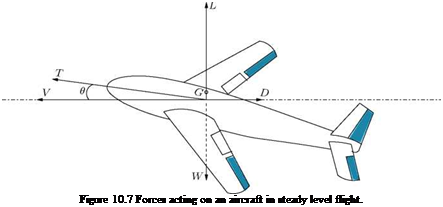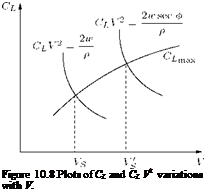Straight Horizontal Flight
The forces acting on an aircraft in straight horizontal flight is shown in Figure 10.7. There are three forces; the thrust T, weight W, and aerodynamic force Fad acting on the aircraft. The components of Fad in the direction of V and normal to V, respectively, are the lift L and drag D.
By proper choice of chord the incidence may be taken equal to the attitude and
L = W – T sin в D = T cos в.
In practice в is small, so that T = D, L = W, and
![]() ^ L W w
^ L W w
L = 1 pV2S = 2pV2S = 2pV2 ’
 |
where w = W/S is called the wing loading, that is, the average load per unit area of wing plan. When w, p (that is altitude), and V are given, CL is determined, and therefore incidence from the CL versus а graph (Figure 10.3).
At the stalling speed VS, Equation (10.1) becomes:
The stalling speed VS can be determined by plotting a graph of CLV2 = 2w/p versus V and CL versus V together, as shown in Figure 10.8.
It is seen that the stalling speed VS increases with altitude (that is, with decrease of flow density p). From Equations (10.1) and (10.2), we have:
 |
CL^1PV2) = CLmax (jPV^j = W. (10.3)
The air-speed indicator measures 1pV2 but is graduated to read V. It is, therefore, correct only for the particular value of the density p for which it is graduated, but, if we neglect variations of CLmax, it follows from Equation (10.3) that the aircraft will stall always at the same indicated airspeed when it is in straight horizontal flight, whatever the height.











